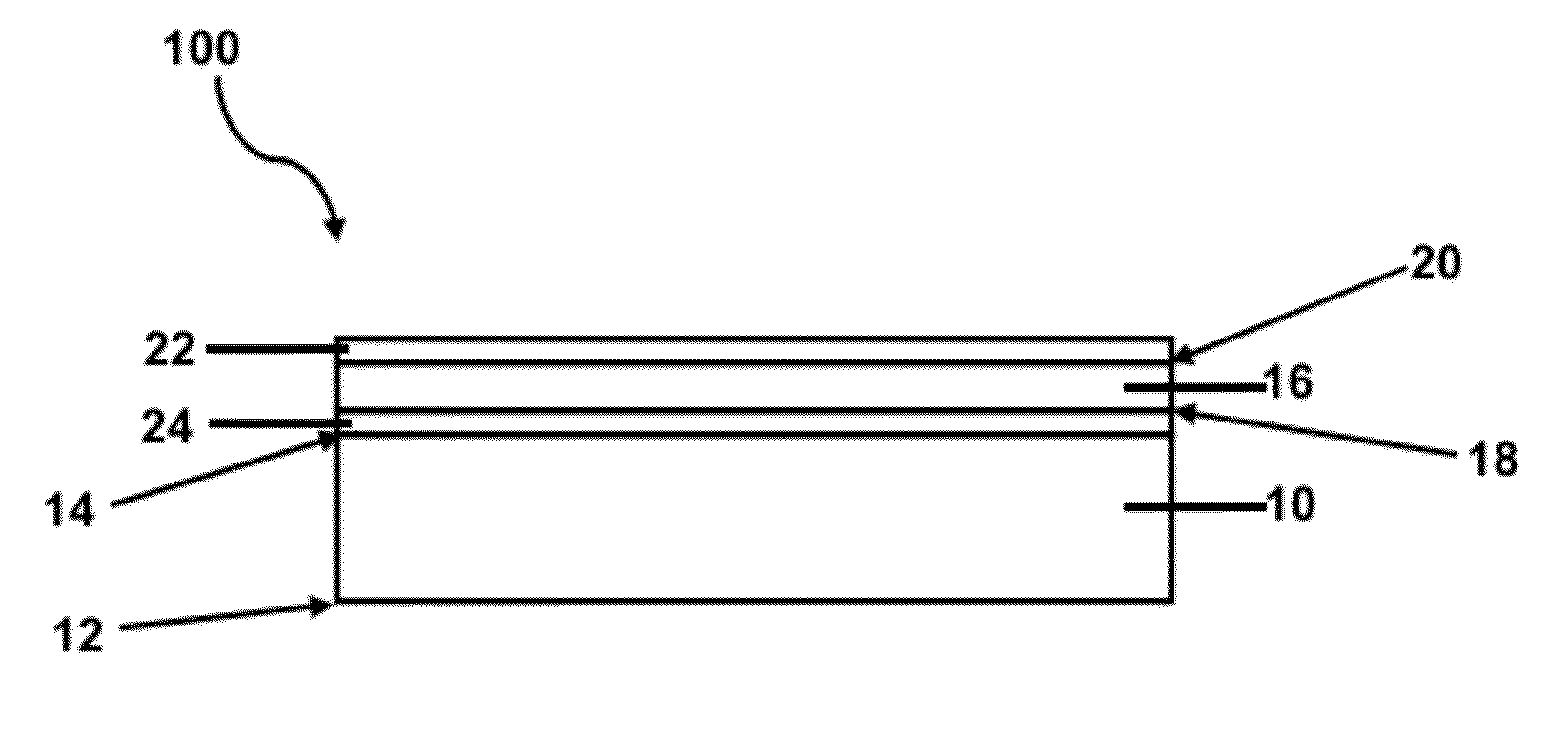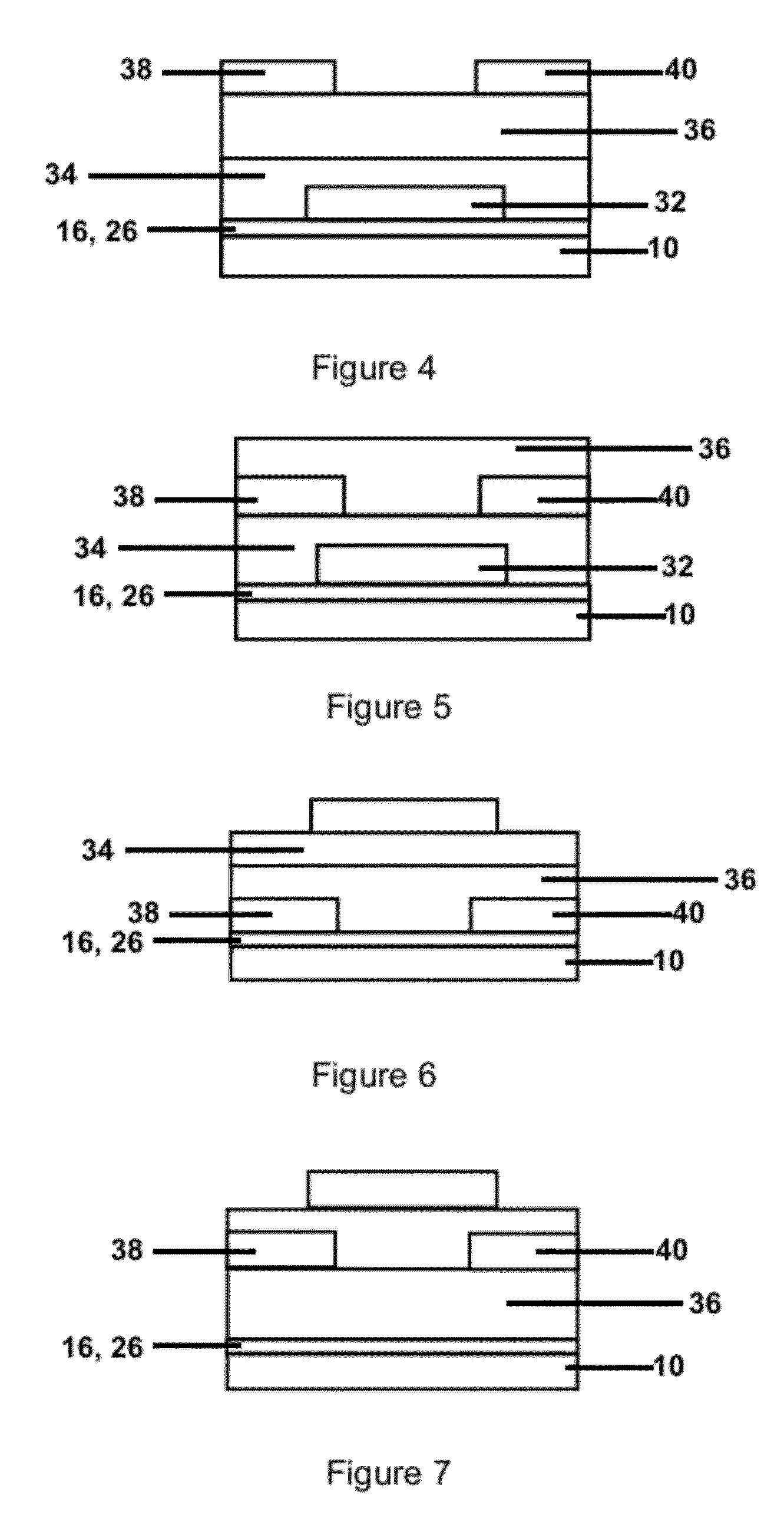Laminated structure for semiconductor devices
a semiconductor device and laminate technology, applied in the field of semiconductor devices, can solve the problems of device failure, limiting device durability, and fracturing of glass backplane substrates as dominant failure modes of current e-readers
- Summary
- Abstract
- Description
- Claims
- Application Information
AI Technical Summary
Benefits of technology
Problems solved by technology
Method used
Image
Examples
example 1
Organic Bottom Gate, Top-Contact TFT on Ion-Exchange Glass
[0057]A TFT device can be fabricated by solution casting a thin layer of organic semiconducting materials such as thiophene copolymers onto a polymer dielectric layer.
[0058]This exemplary method comprises cleaning ion-exchanged glass substrates by using sonication in acetone and then isoproponol; depositing a patterned gold (Au) gate electrode at 2 Angstroms per second (Å / s) for 30 nm; spin-casting a mixture of 11 weight percent (wt %) (film thickness ˜800 nanometers (nm) to 1 um) poly vinyl-phenol (PVP) solution in Propylene Glycol Methyl Ether Acetate (PGMEA) and Melamine at 1000 rotations per minute (rpm) for 30 seconds (sec); and curing this layer by ultraviolet (UV)-light for less than 3 min. The method further comprises dissolving 3 milligrams per milliliter (mg / mL) of P2TDC17FT4 (organic semiconducting polymer) in 1,2-dichlorobenzene and spin-coating the solution; annealing the whole devices at 100° C. for 30 mins on a...
example 2
Bonding Flexible Glass Layer to an Ion-Eexchanged Glass Substrate and Fabricating a Transistor on the Flexible Glass Layer
[0059]As mentioned previously, a flexible glass substrate can be bonded to a mechanically durable ion-exchanged glass substrate to produce a composite structure. This composite structure offers the alkali-free flexible glass surface for high quality TFT fabrication and performance. It also provides the high mechanical durability of the ion-exchanged glass.
[0060]The flexible glass layer can be made from an alkali-free glass composition and drawn to thicknesses of <300 um. For example, the flexible glass can have a thickness of 300 um or less, for example, 200 um or less, for example, 100 um or less, for example, 50 um or less. The flexible glass could have the dimensional tolerances and surface quality of typical fusion drawn LCD substrates to enable the fabrication of high performance TFT on its surface.
[0061]The ion-exchanged glass substrate can have a thickness...
example 3
Organic TFT Device Built on Flexible Glass Layers
[0065]To demonstrate the ability of fabricating organic semiconductor devices on flexible glass, an organic TFT backplane was fabricated on 100 um thick flexible glass substrates. The fabrication of the OTFTs began with an organic hard coating which was spin-coated on the flexible glass as an adhesion promoter. The source and drain electrodes were formed by thermal-evaporated gold on the organic hard coating. The highly air-stable polymer semiconductor was then spin-coated and patterned by photolithography. A dielectric layer of 510 nm thick poly vinyl-phenol (PVP) was deposited and subsequently the gate electrode made of 50 nm gold metal was formed. Finally, 30 nm-thick organic interlayer film were spin-coated and the patterning of this film was done by photolithography again. Note that the via-holes through the interlayer and the dielectric to drain electrode were done by inductively coupled plasma reactive ion etcher. When fabricat...
PUM
| Property | Measurement | Unit |
|---|---|---|
| Length | aaaaa | aaaaa |
| Force | aaaaa | aaaaa |
| Depth | aaaaa | aaaaa |
Abstract
Description
Claims
Application Information
 Login to View More
Login to View More - R&D
- Intellectual Property
- Life Sciences
- Materials
- Tech Scout
- Unparalleled Data Quality
- Higher Quality Content
- 60% Fewer Hallucinations
Browse by: Latest US Patents, China's latest patents, Technical Efficacy Thesaurus, Application Domain, Technology Topic, Popular Technical Reports.
© 2025 PatSnap. All rights reserved.Legal|Privacy policy|Modern Slavery Act Transparency Statement|Sitemap|About US| Contact US: help@patsnap.com



